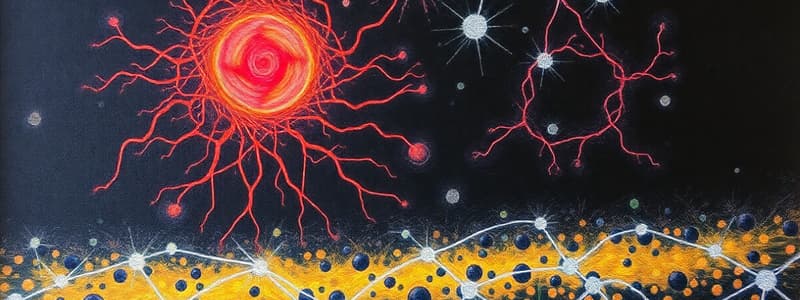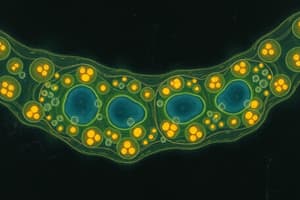Podcast
Questions and Answers
What is the primary function of gap junctions in cells?
What is the primary function of gap junctions in cells?
- Transporting signal molecules only
- Providing structural support to cells
- Allowing passage of cytoplasmic molecules (correct)
- Facilitating cell adhesion
Which of the following best describes the selectivity of the plasma membrane?
Which of the following best describes the selectivity of the plasma membrane?
- Completely permeable only to water
- Permeable to all substances equally
- Selectively permeable and hydrophobic (correct)
- Impermeable to all molecules
How does temperature influence the rate of diffusion?
How does temperature influence the rate of diffusion?
- Higher temperatures increase molecular kinetic energy, speeding up diffusion (correct)
- Temperature has no effect on diffusion rates
- Higher temperatures slow down diffusion rates
- Cooling increases the size of molecules, enhancing diffusion
Which type of transport mechanism does not require carriers and occurs if a molecule is lipid-soluble?
Which type of transport mechanism does not require carriers and occurs if a molecule is lipid-soluble?
Which of the following is not a role of plasma membrane proteins?
Which of the following is not a role of plasma membrane proteins?
What is the main factor that influences the concentration gradient in diffusion?
What is the main factor that influences the concentration gradient in diffusion?
Which type of diffusion specifically involves water-soluble substances that require help to cross the membrane?
Which type of diffusion specifically involves water-soluble substances that require help to cross the membrane?
Why must cells maintain a balance of extracting needed items and discarding waste?
Why must cells maintain a balance of extracting needed items and discarding waste?
What is exocytosis primarily involved in?
What is exocytosis primarily involved in?
What does receptor-mediated endocytosis enable a cell to do?
What does receptor-mediated endocytosis enable a cell to do?
Which mechanism is primarily used to engulf bacteria during endocytosis?
Which mechanism is primarily used to engulf bacteria during endocytosis?
What is a key feature of vesicle docking during exocytosis?
What is a key feature of vesicle docking during exocytosis?
Which type of endocytosis is characterized by the ingestion of liquid and dissolved substances?
Which type of endocytosis is characterized by the ingestion of liquid and dissolved substances?
What role does ATP play in the process of vesicular transport?
What role does ATP play in the process of vesicular transport?
What is one of the primary functions of endocytosis?
What is one of the primary functions of endocytosis?
What characterizes the process of exocytosis?
What characterizes the process of exocytosis?
Which molecules pass through the plasma membrane by simple diffusion?
Which molecules pass through the plasma membrane by simple diffusion?
What characterizes facilitated diffusion?
What characterizes facilitated diffusion?
What is the key difference between carrier-mediated and channel-mediated facilitated diffusion?
What is the key difference between carrier-mediated and channel-mediated facilitated diffusion?
Which statement accurately describes osmosis?
Which statement accurately describes osmosis?
How does water entry affect plant cells compared to animal cells?
How does water entry affect plant cells compared to animal cells?
What determines the osmolarity of a solution?
What determines the osmolarity of a solution?
What type of transport mechanism does not require energy and involves specific proteins?
What type of transport mechanism does not require energy and involves specific proteins?
Which of the following correctly describes how channel-mediated facilitated diffusion operates?
Which of the following correctly describes how channel-mediated facilitated diffusion operates?
Flashcards
Gap Junctions
Gap Junctions
Molecular channels between cells that allow cytoplasmic molecules to pass through.
Connexons
Connexons
Protein channels that form gap junctions.
Plasma Membrane Proteins
Plasma Membrane Proteins
Proteins embedded in the plasma membrane with various functions like transport, joining cells, catalyzing reactions, and recognizing other cells.
Passive Transport
Passive Transport
Signup and view all the flashcards
Simple Diffusion
Simple Diffusion
Signup and view all the flashcards
Facilitated Diffusion
Facilitated Diffusion
Signup and view all the flashcards
Carrier-Mediated Facilitated Diffusion
Carrier-Mediated Facilitated Diffusion
Signup and view all the flashcards
Channel-Mediated Facilitated Diffusion
Channel-Mediated Facilitated Diffusion
Signup and view all the flashcards
Osmosis
Osmosis
Signup and view all the flashcards
Osmolarity
Osmolarity
Signup and view all the flashcards
Tonicity
Tonicity
Signup and view all the flashcards
Vesicular Transport
Vesicular Transport
Signup and view all the flashcards
Exocytosis
Exocytosis
Signup and view all the flashcards
Endocytosis
Endocytosis
Signup and view all the flashcards
Phagocytosis
Phagocytosis
Signup and view all the flashcards
Pinocytosis
Pinocytosis
Signup and view all the flashcards
Receptor-Mediated Endocytosis
Receptor-Mediated Endocytosis
Signup and view all the flashcards
Neuron
Neuron
Signup and view all the flashcards
Action Potential
Action Potential
Signup and view all the flashcards
Synapse
Synapse
Signup and view all the flashcards
Neurotransmitters
Neurotransmitters
Signup and view all the flashcards
Study Notes
Gap Junctions
- Molecular channels between cells allow passage of cytoplasmic molecules.
- Connexons are the protein channels that form gap junctions.
- Electrically excitable tissues, such as heart muscle and smooth muscle, utilize gap junctions for rapid communication.
Plasma Membrane Proteins
- Transport: Movement of substances across the membrane.
- Intercellular Joining: Connection between cells, such as gap junctions.
- Enzymatic Activity: Catalyzing specific chemical reactions within the cell.
- Cell-cell Recognition: Identifying and interacting with other cells.
- Receptors for Signal Transduction: Binding to signaling molecules and initiating intracellular responses.
- Attachment to ECM: Connecting the cell to the extracellular matrix.
Plasma Membrane
- Acts as a selectively permeable hydrophobic barrier between the interstitial fluid and the cytoplasm.
- Interstitial fluid is a blood filtrate containing salts, sugars, amino acids, vitamins, hormones, metabolites, and gases such as O2 and CO2.
- To maintain homeostasis and function, cells must extract necessary substances, retain valuable materials, and eliminate waste.
Passive Transport
- Three types: simple diffusion, facilitated diffusion, and osmosis.
- Diffusion: The tendency of molecules or ions to distribute evenly.
- Factors influencing diffusion rate:
- Concentration gradient slope: Steeper gradient, faster diffusion.
- Molecule size: Smaller molecules diffuse faster.
- Temperature: Higher temperature, faster diffusion.
- The hydrophobic nature of the plasma membrane requires molecules to be lipid-soluble or utilize channels/transporters to cross.
Simple Diffusion
- Doesn't require carriers.
- Occurs for lipid-soluble nonpolar substances like O2, CO2, fats, urea, and alcohol.
- O2 follows its concentration gradient into the cell, while CO2 flows out.
- Movement occurs down the concentration gradient.
Facilitated Diffusion
- Requires carriers or channels to assist water-soluble substances across the membrane.
- Features:
- Specific: Transports certain molecules only.
- Not ATP-requiring: Doesn't use energy directly.
- Limited by carrier/channel saturation: Maximum transport rate can be reached.
- Down concentration gradient: Movement follows the concentration difference.
Carrier-Mediated Facilitated Diffusion
- Transports large lipid-insoluble molecules unable to pass through membrane pores/channels.
- Glucose is a prominent example of a substance transported via carrier-mediated facilitated diffusion.
Channel-Mediated Facilitated Diffusion
- Uses protein channels for transport.
- Selectivity based on pore size and amino acid charges lining the channel.
- Types:
- Leaky channels: Always open.
- Gated channels: Regulated opening.
- Movement is still down the concentration gradient.
- Can be inhibited, show saturation, and are usually specific.
Osmosis
- The unassisted diffusion of water from an area of higher water concentration to an area of lower water concentration across a semipermeable membrane.
- Water being polar but small allows for movement across the plasma membrane directly.
- Specialized water channels called aquaporins are present on many cells.
- In plant cells, excess water entry can lead to turgor pressure.
- In animal cells, excess water entry can lead to lysis (cell bursting).
Osmolarity and Tonicity
- Osmolarity: Total concentration of solute particles in a solution.
- Tonicity: The effect a solution has on cell volume.
Vesicular Transport
- Active transport mechanisms involving ATP-requiring vesicle movement.
- Includes exocytosis and endocytosis.
Exocytosis
- Secretes hormones, neurotransmitters, mucus, and ejects waste.
- Substance enclosed in a vesicle moves to the plasma membrane, fuses, ruptures, and releases contents outside the cell.
- Vesicle docking involves v-SNAREs (vesicle-associated membrane proteins) and t-SNAREs (target membrane-associated proteins).
Endocytosis
- Large particles enter the cell.
- A vesicle encloses the substance, pinches off, and moves into the cytoplasm.
- Contents may be digested or move to the other side of the cell for exit.
- Types:
- Phagocytosis: Engulfing bacteria, cell debris.
- Pinocytosis: Ingesting fluid and dissolved substances.
- Receptor-mediated endocytosis: Concentrating hormones, enzymes, or other macromolecules within a cell.
Neurons
- Conduct electrical impulses between body parts.
- Features:
- Extreme longevity: Can last over 100 years with proper nourishment.
- Special structures and functions related to reception, propagation, and transmission of nerve impulses.
Neuron Regions and Functions
- Dendrites: Receive signals from other neurons.
- Cell body (soma): Integrates incoming signals and initiates action potentials.
- Axon: Transmits signals to other neurons or target tissues.
- Axon terminal: Releases neurotransmitters at synapses.
Electrical Activity of Neurons
- Resting membrane potential: The difference in electrical charge across the neuron's membrane when it is not transmitting signals.
- Action potential: A brief electrical impulse that travels along the axon.
Action Potential Generation
- Influenced by:
- Diffusion of ions across the cell membrane.
- Types of ion channels:
- Sodium channels
- Potassium channels
- Calcium channels
Propagation of Action Potential
- Factors affecting propagation speed:
- Axon diameter: Larger diameter, faster conduction.
- Myelination: Presence of myelin sheath, faster conduction.
Synaptic Transmission
- Synapse: Junction between a neuron and another cell (neuron, muscle, or gland).
- Postsynaptic potentials: Changes in the membrane potential of the postsynaptic cell caused by neurotransmitter release.
- Synaptic integration: The process of combining multiple synaptic inputs to determine the overall response of a neuron.
Neurotransmitters
- Chemicals released at synapses that transmit signals between neurons.
- Examples: acetylcholine, dopamine, serotonin, norepinephrine, glutamate, GABA.
Neural Circuits
- Networks of interconnected neurons that process and transmit information.
- Examples: sensory circuits, motor circuits, reflex circuits.
Studying That Suits You
Use AI to generate personalized quizzes and flashcards to suit your learning preferences.




